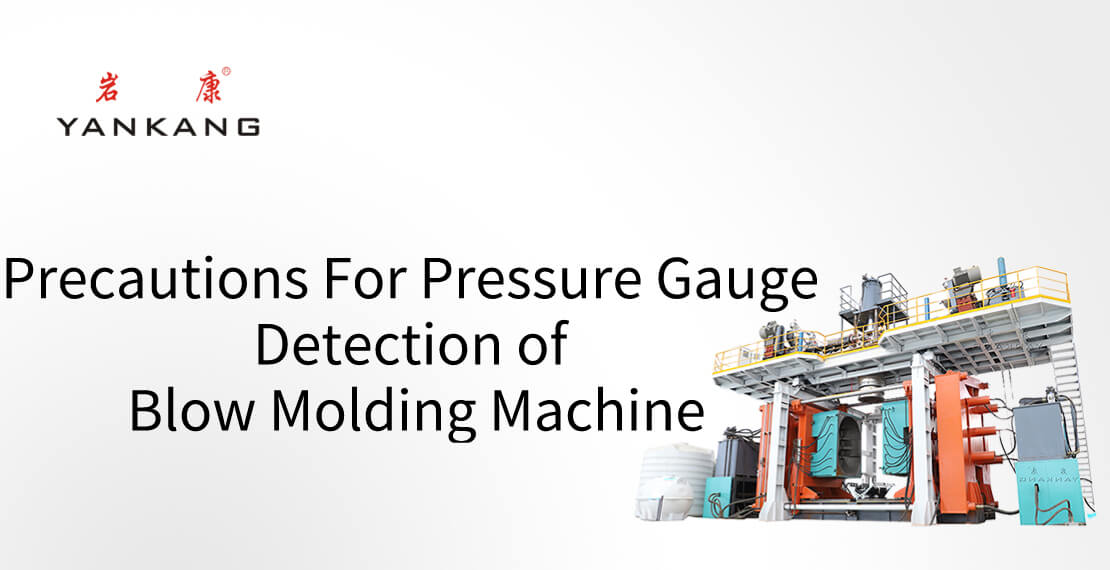Today, let’s talk about the precautions for the pressure gauge detection of blow molding machines.
The blow molding machine pressure gauge is an important pressure reference instrument. Before installation, it needs to be inspected by the relevant national measurement units, and the relevant inspection qualification certificate will be presented after the inspection is qualified. To ensure the qualification and accuracy of the pressure gauge, it can be determined according to the frequency of use. Generally, the measurement verification of the pressure gauge should not exceed 6 months.
The precautions for the inspection of the pressure gauge of the blow molding machine are as follows:
1. Perform metrological verification operations in accordance with specifications.
Inspectors can carry out the measurement and verification of pressure gauges through the regulations of the elastic element type general pressure gauge, pressure vacuum gauge, and vacuum gauge JJG52-2013. According to the range of the pressure gauge to be tested, the verifier needs to select the calibration instrument corresponding to the range, and at the same time, check the validity period of the label of the standard meter according to the specified inspection operation, so that the inspection work of the pressure gauge meets the verification requirements.
2. Install the calibration instrument according to the type of pressure gauge.
When performing pressure gauge measurement and testing, it is necessary to install the standard gauge and the tested pressure gauge on the calibration instrument. If the tested pressure gauge is an oxygen-type oil-free pressure gauge, the tested pressure gauge needs to be installed on the oil-free joint that is connected to the oil-water separator, and the calibrator should be adjusted after the installation operation to make all parts Able to be in a good state of verification.
3. Observe the temperature and humidity of the verification room.
To ensure the accuracy of the pressure gauge measurement verification, it is necessary to measure the temperature and humidity of the verification room before the pressure gauge measurement verification to check whether the room temperature and humidity meet the specified operating limits.
4. Check whether the pressure gauge meets the operating requirements.
In the process of metrological verification of pressure gauges, the appearance and internal parts of the pressure gauge shall be inspected to see if they meet the operational requirements of metrological verification, and the corresponding inspection results shall be recorded after the inspection is completed.
5. Reasonably carry out the verification of the display value of the pressure gauge.
For the measurement verification of the displayed value of the pressure gauge, it is necessary to perform the verification of the pressure increase and the pressure reduction according to the graduation line of the digital mark, and the stable and slow operation requirements shall be followed during the verification so that the standard gauge should be in the corresponding position. , To be able to accurately record the value of the inspected indication.
6. Use standardized methods for metrological verification.
The indication value of the pressure gauge should be verified according to the 5/1 division value. During the verification process, the standard meter is verified according to the line reading, and the tested meter is verified according to the estimated reading. For the errors generated in the verification process, it is necessary to carry out the error according to the specification and make relevant records after the error verification operation.
7. Check whether the pressure gauge is installed in an easy-to-observe position.
When selecting the installation location of the pressure gauge, it is necessary to choose a location that is easy to observe for installation, so that the pressure gauge can be observed and treated with dirt. In order to improve the accuracy of the pressure gauge, it is necessary to install the pressure gauge in a location that is not exposed to direct sunlight and high temperature to avoid radiant heat, freezing, and vibration of the pressure gauge due to external factors.
8. Check whether the body of the pressure gauge is in the vertical direction.
When installing the pressure gauge body, it is necessary to control the pressure gauge body in the vertical direction so that the staff can read the display value of the pressure gauge. If the pressure gauge needs to be installed at a higher position, it can be adjusted vertically by tilting it forward, but the tilt angle cannot exceed 30 degrees.
9. Check whether a buffer tube is installed in front of the pressure gauge.
After the installation of the pressure gauge is completed, a buffer tube needs to be installed in front of the pressure gauge to prevent the pressure gauge from being affected by external air. The buffer tube, as a guarantee facility for the pressure gauge, can relieve the gas in the spring tube, and the buffer tube has a certain condensate collection function, which can prevent excessive gas in the pressure gauge.
10. Check whether a three-way cock or type valve is installed.
At the bending part of the pressure gauge buffer tube, it is necessary to install the three-way cock or type valve at a suitable intermediate position, so that the three-way cock or type valve can guarantee the safety of the pressure gauge.、
In a word, when installing and operating the pressure gauge of the blow molding machine, the installation environment needs to be analyzed, so as to carry out the reasonable installation of the pressure gauge according to the actual installation environment, and whether to ensure that the pressure gauge is in a stable and safe environment.
The above content is the precautions for the inspection of the pressure gauge of the blow molding machine

